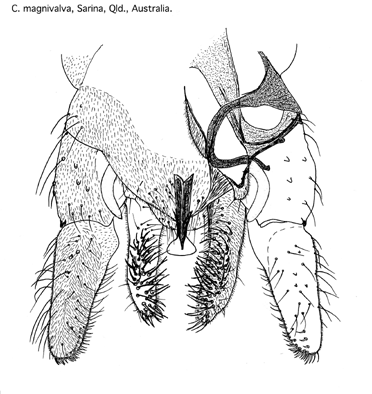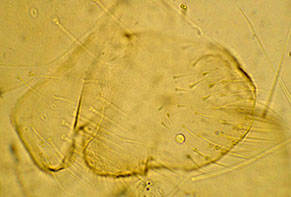C. magnivalva Kieffer, 1917Returned to Chironomus by Bugledich et al. (1999). Synonyms: Chironomus crassiforceps - incorrect synonymy by Guryev et al. (2001) and Peck et al. (2002). Tokkunaga (1964) misidentified C. magnivalva from Micronesia as C. crassiforceps. The nearest neighbour is BOLD:ACC5271 which contains C. crassiforceps Adult:  From Freeman (1961) Antennal ratio (AR): Kieffer gave the AR as about 2, while Freeman pushed this up to 2.5. However in one specimen that he measured, it is only about 1.5. Tokunaga (1964) gives the AR of Micronesian specimens as 1.55 (1.48-1.65). Wing Length: 2.54 (2.32-2.83) mm; wing width: 0.64 (0.48-0.68) mm., VR about 1.08 (1.05-1.15); 2.3 (2-3) Scf on brachiolum; 11.1 (10-13) setae on squamal fringe. Head: Frontal tubercles about 23-36 µm., generally columnar, and about twice as long as wide; 28.6 (19-44) clypeal setae. Palpal proportions (micron): 48 : 46 : 155 : 147 : 213; P5/P4 1.42 (1.20-1.75); P5/P3 1.37 (1.15-1.57). Thoracic setae: Acrostichals 12.1 (10-13); Dorsocentrals 17 (15-21); prealars 5 (4-6); scutellars in two rough rows, 4-9 in anterior row, 8-11 in posterior row, total 15.3 (13-17). LR about 1.59. Leg lengths (microns) and proportions as follows:  Illustration of the hypopygium of C. magnivalva No setae on TIX; anal point downturned with two distinct dorsal ridgesa flattened triangular tip. Superior volsella normal, closest to E(i) type of Strenzke (1959); Inferior volsella also relatively normal, with simple setae on inner margin only, and extending to mid-point or tip of gonostylus. Gonostyle normally broadest at base, but sometimes quite swollen, narrowing slightly and evenly along its length; with numerous spines rather than setae at the tip. Female:  Cercus and segment X of C. magnivalva Guryev et al. (2001) and Peck et al. (2002) referred Australian specimens from the Alligator Rivers region of the Northern Territory to C. crassiforceps. However this is incorrect - see note on the cytology under the larva. A possible point of difference in the morphology of the males is that, while the gonostyle of C. magnivalva narrows evenly to the distal end, that of C. crassiforceps appears to remain the same width for most of its length and then rounds off. Molecular Data: Queensland - Noosaville; Sarina (25.36°S, 149.20°E); Townesville (Type locality); South Townsville (19.43°S, 146.80°E); Common, Townsville (19.36°S, 146.70°E). Also: - Motu Kö, Pukapuka, Cook Islands (10.88°S, 165.51°W) (E.H. Bryan Jr., Bishop Museum). Cytologically identical material has been collected from Lautoka (17.67°S, 177.50°E) and Laucola Bay (18.25°S, 178.33°E), Viti Levu, Fiji and Punaauia, Tahiti (17.53°S, 149.57°E). |
Modified: 31 March 2023
Access: Unrestricted
Copyright © 2005-2023, Jon Martin.